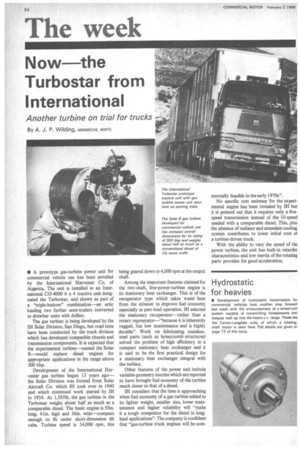Now the Turbostar from International
Page 56

If you've noticed an error in this article please click here to report it so we can fix it.
Another turbine on trial for trucks
By A. J. P. Wilding, AMIMECHE, MIRTE • A prototype gas-turbine power unit for commercial vehicle use has been unveiled by the International Harvester Co. of Morica. The unit is installed in an International CO-4000 6 x 4 tractive unit designated the Turbostar, and shown as part of a "triple-bottom" combination—an artic hauling two further semi-trailers converted to drawbar units with dollies.
The gas turbine is being developed by the IH Solar Division, San Diego, but road tests have been conducted by the truck division which has developed compatible chassis and transmission components. It is expected that the experimental turbine—named the Solar B—would replace diesel engines for appropriate applications in the range above 300 bhp.
Development of the International Harvester gas turbine began 13 years ago— the Solar Division was formed from Solar Aircraft Co. which Hi took over in 1960 and which continued work started by III in 1954. At 1,5851b, the gas turbine in the Turbostar weighs about half as much as a comparable diesel. The basic engine is 50in. long, 41in. high and 36in. wide—compact enough to fit under short-dimension tilt cabs. Turbine speed is 34,000 rpm, this being geared down to 4,000 rpm at the output shaft.
Among the important features claimed for the two-shaft, free-power-turbine engine is its stationary heat exchanger. This is of the recuperator type which takes waste heat from the exhaust to improve fuel economy especially at part-load operation. IH selected the stationary recuperator—rather than a rotary regenerator—"because it is inherently rugged, has low maintenance and is highly durable". Work on fabricating stainlesssteel parts (such as honeycomb structures) solved the problem of high efficiency in a compact stationary heat exchanger and it is said to be the first practical design for a stationary heat exchanger integral with the turbine.
Other features of the power unit include variable-geometry nozzles which are reported to have brought fuel economy of the turbine much closer to that of a diesel.
IH considers that the time is approaching when fuel economy of a gas turbine added to its lighter weight, smaller size, lower maintenance and higher reliability will "make it a tough competitor for the diesel in longhaul applications". The company is confident that "gas-turbine truck engines will be com mercially feasible in the early 1970s".
No specific cost estimate for the experimental engine has been revealed by IH but it is pointed out that it requires only a fivespeed transmission instead of the 10-speed needed with a comparable diesel. This, plus the absence of radiator and attendant cooling system contributes to lower initial cost ol a turbine-driven truck.
With the ability to vary the speed of the power turbine, the unit has built-in retardet characteristics and low inertia of the rotating parts provides for good acceleration.




































































































































































































